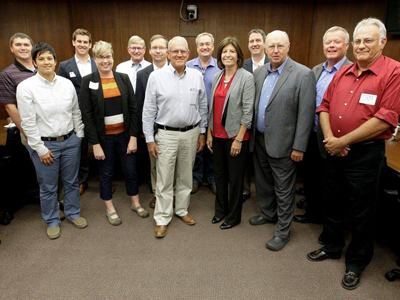Watershed Wednesday: Learning from watershed neighbors
posted
on Wednesday, January 27, 2016
Note: This is the final article in a month-long Watershed Wednesday series on a watershed approach for Iowa. Click here to view other posts in the series that highlight model watershed projects in Iowa or to view the Council’s white paper: Healthy Lands, Healthy Waters: A Watershed Framework for Iowa.
 |
| From left, back row: Ross Evelsizer, Northeast Iowa Resource, Conservation and Development; Evan Del Val, ISG Engineering Group; Minnesota State Rep. Paul Anderson (R-District 12B) ; Jim Jordahl, Iowa Agriculture Water Alliance; Minnesota State Rep. Rick Hansen (D-District 52A); Rich Leopold, Polk County Conservation Board; Iowa Rep. Charles Isenhart (D-Dubuque). From left, front row: Vanessa Fixmer-Oraiz, HBK Engineering; Hannah Bates, Prairie Rivers RC&D; Iowa Sen. Ken Rozenboom (R-Oskaloosa), Iowa Sen Rita Hart (D-Wheatland), Iowa Sen. Mark Segebart (R-Vail); and Rod Marlatt, Turkey River Watershed Management Authority. Not pictured, Iowa Rep. Dan Kelley (D-Newton). |
Last fall, a small caravan of Iowans headed north to seek insights on watershed management in Minnesota, the land of 10,000 lakes. The group, organized by Iowa State Representative Chuck Isenhart of Dubuque, included five legislators, both R and D, and several other interested stakeholders.
“When it comes to public policies and practices in any area, sometimes we tend to spend too much time navel-gazing and not enough time looking around and learning,” said Isenhart, ranking member on the House Environmental Protection Committee. “Dirty water is not a problem unique to Iowa. Soil loss, fertilizer loss and flooding are chronic problems in the upper Midwest… So I hope the connections we made on the tour might lead to further collaboration between our states and others in the future.”
One of the tour participants was Evan Del Val of ISG Civil Engineering Group in Des Moines.
“I wanted to learn more about what Minnesota is doing and what people there think about it,” said Del Val.
Minnesota’s “One Watershed, One Plan” is recognized as a national model for aligning state and local water programs on major watershed boundaries. Under this statewide watershed approach, Minnesota is improving water quality while achieving multiple benefits, such as flood prevention, enhanced recreation opportunities and improved quality of life.
There are 81 major watersheds in Minnesota. Under the One Watershed, One Plan approach, management cycles for the watersheds are staggered, with 8 to 10 beginning a new cycle each year. The cycle begins with intensive monitoring and assessment. Results are used to develop a “bottom-up” collaborative plan that sets goals for improvement and priorities for action. As the districts start a new cycle, adaptive management is used to help ensure continuous improvement. By 2017, all watersheds will have at least begun their first cycle, and those that began in 2008 will enter their next cycle. Iowa’s legislature has also endorsed a statewide, rolling cycle approach similar to Minnesota’s in the Iowa Surface Water Protection, Flood Mitigation and Watershed Management Act (Iowa Code 2015, Chapter 466B), but this part of the Iowa Act has not been implemented.
This type of long-term, statewide effort takes sustained support. Minnesota’s watershed approach is funded by its Legacy Amendment tax, which increases the state sales tax by three-eighths of one percent, a third of which goes to a Clean Water Fund. This constitutionally protected account has pumped more than $360 million to 800-plus projects around the state since 1991.
Minnesota’s One Watershed, One Plan also consolidates the state’s many water plans and projects to focus resources more efficiently and effectively. Local watershed districts coordinate across county and municipal boundaries, similar to Iowa’s new watershed management authorities. The statewide effort is administered by the state’s Board of Water and Soil Resources (BWSR), with involvement of county soil and water conservation districts, municipalities, and other stakeholders.
The Iowa delegation met with BWSR representatives in St. Paul to learn more about Minnesota’s approach. Then they proceeded to three counties in southern Minnesota to see projects first-hand and hear local views on watershed programs and funding.
“The conversations that I had with the various stakeholders helped me realize that Iowa is not behind in terms of technical understanding or creative solutions to the problems. Iowans are engaged in these issues and are as knowledgeable and passionate as those I met in Minnesota,” said Del Val. “However, Minnesota has two advantages: A significant, reliable funding source and a strong identification with their natural waters. The trip inspired me to think how we could do more in Iowa to build a sense of water identity and pride unique to our state.”
Those who want to hear more can attend the state’s next Watershed Planning Advisory Council (WPAC) meeting where Del Val will report on some of the highlights of the tour. The WPAC meeting will be Friday, February 5, at 1:00 p.m. at the Urbandale Public Library. The Iowa Environmental Council is co-chair of WPAC and assisted in organizing the Minnesota watershed tour. Support for the tour was provided by the McKnight Foundation and the Mississippi River Museum and Aquarium in Dubuque.
Learn more about MN's watershed approach on the Minnesota Pollution Control Agency website
- conservation
- water quality
- watershed wednesday